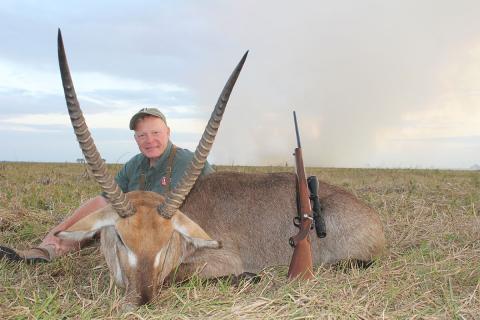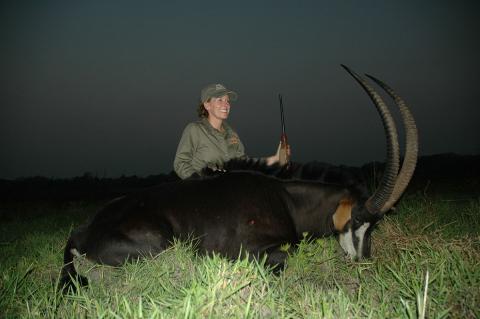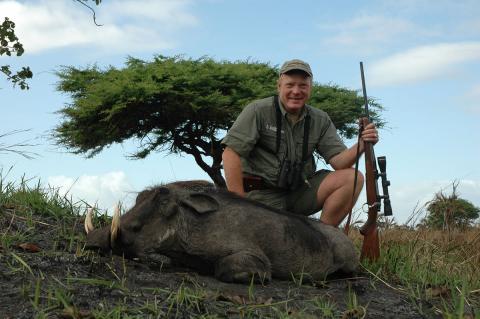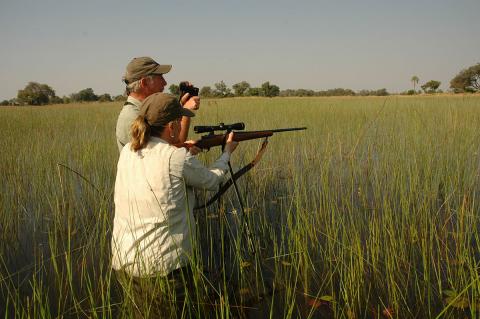.30-06 IN AFRICA
Still one of the most versatile choices…
I crawled onto a low termite mound, rested the rifle over my daypack and snuggled in behind it. A gorgeous waterbuck bull stood with his harem at about 225 yards. Perfect, except he was facing straight away, so I waited for him to turn. Eventually he swung to the right, broadside. The crosshairs were steady and about half the slack was out of the trigger when the whole group took off, running straight away across the open floodplain.
They stopped near the next palm tree. Over my shoulder, PH Julian Moller called, “275 yards.” The bull was still facing away, but in a few more seconds he turned, quartering slightly away. A stiff crosswind blew across the open floodplain so I held a few inches into the wind and just above an imaginary horizontal halfway line. The bullet smacked hard and the bull bucked with the impact, then ran straight away. After a few yards he slowed, visibly wobbling, and went down to stay.
Forty-two years earlier I’d had a similar scenario with my first waterbuck, one of my first African animals. Distance and shot presentation were the same. The rifle and cartridge were also familiar. Back then, on the lower terraces of Mount Kenya, I was using a “bicentennial year” Ruger Model 77. Just now, on the floodplains of Coutada 11 in coastal Mozambique, I was using a Ruger M77 MkII made a quarter-century later. Both rifles were chambered to .30-06.
There were differences. My 1976 Ruger wore a right-handed bolt. Years would pass before Ruger offered a mirror-image bolt-action and, although always left-handed, I hadn’t yet made the switch to southpaw actions and was perfectly happy reaching over the top to work the bolt. The newer rifle was left-handed and had the control-round-feed and cocking-piece safety of the MkII.
The loads also weren’t the same. Back then I was shooting handloaded 180-grain Nosler Partitions. This year in Mozambique, I was shooting Hornady Custom with 180-grain Interlock bullets. The waterbuck is a tall, deep-chested antelope with long, thick, heavily ringed horns. One of Africa’s most majestic antelopes. The waterbuck is large and powerful, with mature bulls weighing up to 600 pounds. This is not a problem for the .30-06. In both situations the result was the same, quickly final.
A LONG LINEAGE
Although it became a worldwide standard, our “Ball Cartridge, Caliber .30, Model of 1906” is very much an American cartridge, our standard military cartridge for 50 years. Its similar predecessor was introduced with the Springfield bolt-action in 1903, using a long-for-caliber 220-grain round-nosed bullet. By this time European powers were switching to aerodynamic sharp-pointed (spitzer) bullets at higher velocity. The 1906 shift to a lighter spitzer included a slight case dimension change, with the neck shortened by .07-inch. There were thus two versions: The original “.30-03” and the “.30-06.”
For some years, factory ammo was available for both, but this hasn’t been a big deal for a century. The later and current .30-06 cartridge (with shorter neck) will chamber and safely fire in all rifles from 1903 onwards, but the older .30-03 cartridge (with longer neck) will not chamber in post-1906 rifles. This has historical significance because the .30-06 was introduced to Africa by Theodore and Kermit Roosevelt on their epic 1909 safari.
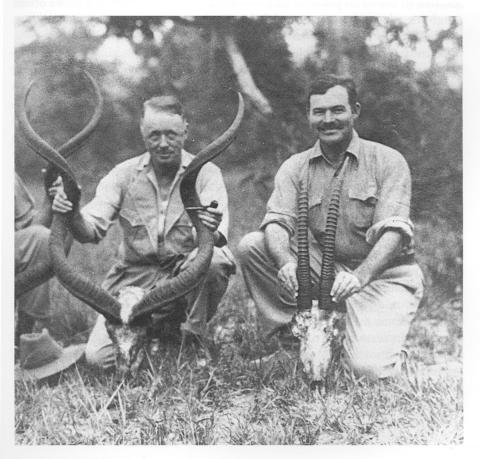
The 1903 Springfield with sporter stock and “civilian” sights that President Roosevelt used in Africa remains at the Springfield Armory Museum. I have held that rifle in my (gloved) hands, a real goose-bump moment! Here’s what is interesting: Roosevelt’s Springfield was (and still is) a .30-03, never actually a .30-06!
For better accuracy, most military .30-03 rifles were modified to .30-06 by turning the barrel back two threads and re-cutting the chamber—but Theodore Roosevelt’s Springfield was not modified. Since either version would have chambered and fired, it isn’t clear whether the Roosevelts used .30-03 or .30-06 ammunition.
Either way, the Springfield rifles performed well and left a lasting impression. A few years later, one of Roosevelt’s Kenya hosts, pioneer PH Leslie Tarlton, described the “American .30” as “the best of the small-bores.” There were, of course, many choices. Some African hunters gravitated to early 6.5 and 7mms, and many of British origin clung to the .303.
Americans were most likely to use a .30-06. On the 1933 safari that gave us Green Hills of Africa, Ernest Hemingway used a .30-06 Springfield by Griffin & Howe. He also had a Mannlicher in 6.5×54 and a double .470, but preferred the Springfield and used it for most of his game. In 1952, on his Horn of the Hunter safari, Robert Ruark had a .375 H&H and a Westley Richards .470—but most of his plains game was taken with a Remington .30-06, presumably a Model 721.
A quarter-century later when I prepared for my first safari, I bought that 1976 Ruger M77 at the Camp Pendleton PX. However, at that stage I was not yet a .30-06 fan. My first centerfire rifle was a surplus Springfield, lovingly (and very roughly) sporterized, but I didn’t hunt with it.
Child of the first magnum craze that I was, in the early 1970s I had a .270 and a .300 Winchester Magnum and an “Africa-ready” .375, but I’d done most of my hunting with a .264 Winchester Magnum. So, my choice of the .30-06 was a departure. Based on its long history in Africa, and already a hopeful journalist, a .30-06 seemed the obvious choice.
And wow, what a great choice it was! The .375 was used to hunt buffalo, eland and the lion I didn’t get. Everything else fell to the .30-06, from duiker and dik dik on up to oryx, hartebeest, zebra and, of course, waterbuck. On the Tsavo plains some shots were long, but it didn’t matter. That .30-06, topped with a Redfield 3-9X (my first variable scope) handled everything, as did a single 180-grain Partition.
That Ruger .30-06 served me well on more safaris, then was lost in a burglary. Over the next 20 years I used a number of different rifles and cartridges: .270s, 7mms, .300s, .33s and, in the mix, a Remington .30-06, usually stoked with plain old Core-Lokt bullets that it shot very well. With its variety and abundance of game, Africa is a great proving ground for rifles, cartridges and bullets. Always given good shot placement, I learned that many combinations worked well, but nothing stands out as working better than the great old .30-06.
I got the left-hand Ruger .30-06 in the early 2000s. With Donna also hunting, also left-handed but six inches shorter than me, I shortened the stock a wee bit so we could both use it. For most of a decade this was our “go to” rifle for African plains game and also used for leopard. It saw service in several countries and accounted for a lot of African game. It would be incorrect to say it never missed, but if we did our job the .30-06 always came through.
Over the last few years, and for no particular reason, we got out of the “.30-06 habit.” Donna started using the .270 more (also a great choice) and we both started using the Blaser system. We have .270, .308, .300, and .375 barrels but, also for no particular reason, we never added a .30-06 barrel.
In 2019, I took the left-hand Ruger .30-06 out of retirement for our annual hunt in coastal Mozambique’s Coutada 11 with Zambeze Delta Safaris. We were in camp with a group of friends and didn’t take a lot of game, but I was struck once again by how versatile and effective the .30-06 really is, especially in Africa.
STILL A GREAT CHOICE
Using 220-grain solids, both Roosevelt and Hemingway used the .30-06 for thick-skinned dangerous game and Ruark wrote about taking buffalo with his .30-06. Jack O’Connor’s wife, Eleanor, an accomplished hunter in her own right, didn’t care for recoil. She considered the .30-06 a “big gun,” often choosing it for extra-large game. She took her only elephant with a .30-06 and a 220-grain solid. Veteran Zimbabwe PH Peter Johnstone frequently had to deal with problem lions on his farm in northwestern Zimbabwe. He once wrote to me that the .30-06 was his customary and preferred choice.
On dangerous game safaris, I don’t suggest the .30-06 as a “one-rifle” battery and despite its proven effectiveness with extra-heavy bullets, I certainly don’t recommend it for thick-skinned game. I also don’t recommend it for lion, although I think it’s just about perfect for leopard. However, a majority of modern safaris are for plains game only and a “plains game safari” is the most common choice for a first African hunt.
On such a safari most hunters encounter an unfamiliar and unprecedented variety of game, from pygmy antelopes up through warthogs, reedbuck and impala, large antelopes such as kudu, sable, waterbuck and wildebeest, and on up to zebra. The variety encountered and versatility required are daunting and I’m often asked about the “perfect plains game rifle.”
Honest, there are many great choices, and few bad ones. Most of us have a favorite deer rifle that might also be used for elk, this is the range for an ideal plains game rifle. Always and forever, a familiar and trusted rifle is the best choice. It could be a 7mm Remington Magnum, or a .300 magnum, or a .270 or .30-06.
These days, because of its popularity, I’m often asked about the 6.5mm Creedmoor. Sure, you could. I haven’t used the Creedmoor in Africa, but I’ve used the ballistically identical .260 Remington and, in camp with me just now, fellow writer Joseph Von Benedikt used a 6.5×55, also ballistically identical to the Creedmoor. I’ve also used with perfect satisfaction the 7×57 and its ballistic twin, the 7mm-08 Remington. All of these mild cartridges have in common light recoil, which is important.
Unlike a one-animal North American hunt, in Africa the “plains game rifle” will be used daily. The African plains game rifle must be fully adequate for the largest game you intend to hunt and accurate enough and shootable enough to allow shot placement on the smallest game out to a couple hundred yards.
Despite its current popularity, long range shooting is uncommon in Africa. In many areas the vegetation precludes it and most African PHs have seen so much poor shooting by the likes of you and me that they are terrified of it and always remember that in Africa, one drop of blood equals a license filled and fees payable. Your hunting team will get you as close as possible. It’s your job to make the shot and it’s best to make it with a cartridge and bullet of unquestionable adequacy.
Over the years I’ve done very good work on African plains game with various 7mm and .300 magnums, even the 8mm Remington Magnum, .338 Winchester Magnum and .340 Weatherby Magnum. Again, you can. However, I am convinced that magnum power, range and recoil are not needed. I am also convinced that, despite current popularity, the minimalist approach of the 6.5mm Creedmoor and even my beloved 7×57, are not ideal for the larger plains game. Yes, as with magnums, you can, but should you?
This brings us to a small group of standard, non-magnum and fairly powerful cartridges that include .270 Winchester, .280 Remington, .308 Winchester and .30-06. All are extremely effective for the full range of Africa’s non-dangerous game with one exception, Eland. A big eland bull can weigh a ton, thus more than twice the size of anything else. I saw Donna flatten an eland with Federal’s 180-grain Trophy Tip from a .30-06, something else you can do, but it’s questionable if you should. If eland is on the menu, more is needed, but my little group of four standard cartridges will handle the rest. All shoot flat enough for normal African distances, where 300 yards is considered a very long shot and none will kick you into next week. We all have our favorites, but I respectfully submit that the grand old .30-06 remains near-perfect for African plains game.
POWER AND PERFORMANCE
In bullet weight, frontal area and effect on game the all-American .30-caliber beats all smaller calibers and short of the really big stuff, there’s little in our hunting world that a 180-grain .30-caliber bullet can’t handle. Thanks to the tremendous popularity of the .308 Winchester, we tend to think of the .308 and .30-06 as sort of interchangeable in performance. They are close but case capacity wins. The .30-06 runs about 150 fps faster than the .308, more with heavier bullets, translating to flatter trajectory and higher energy yield. The .308 is awesome, but it is not a .30-06.
I don’t necessarily agree with Eleanor O’Connor that the .30-06 is a big gun. From her first hunt onward, Donna has had no trouble with .30-06 recoil, but the .30-06 is not a small gun. Remember that the .30-06 is the most powerful cartridge ever adopted by a major military. Standard today and faster than the loads Roosevelt or Hemingway might have used, is a 180-grain bullet at 2,700 feet per second. This is not slow and, yielding nearly 3,000 foot-pounds of energy, is powerful. Zeroed at 200 yards, drop at 300 yards is a bit less than nine inches. So, on large antelopes at 300 yards, a hold a bit above the horizontal centerline is fine. On smaller antelopes, a backline hold will work. Longer shots are rare in Africa, but, so long as you know the trajectory, are certainly possible with the .30-06.
The best part of the .30-06 is routinely excellent bullet performance. Since 1906 virtually all .30-caliber hunting bullets have been made to perform at .30-06 velocities and they do. Again, I prefer 180-grain bullets. You can go lighter and faster, or you can go slower and heavier. But, as with calibers and cartridges, the bullet you choose for Africa must be able to handle all game from smallest to largest. A 180-grain .30-caliber will do it all.
Over the years I’ve used a full gamut of 180-grain hunting bullets. If you like homogenous alloy, bullets like Barnes X-series, Hornady DGX and Norma Eco-Strike will perform, penetrate and usually exit. If you like to recover pretty bullets (against the hide on the far side), bonded cores such as; Federal Trophy Bonded Tip, Hornady InterBond, Nosler AccuBond and Swift A-Frame and Scirocco will make you proud.
But, at the .30-06’s moderate velocity, lead-core bullets also strut their stuff. The last 20 years I’ve used mostly Hornady Interlock, but the Nosler Partition is still awesome and I’ve been perfectly happy with Sierra GameKing, Remington Core-Lokt and Winchester Power Point.
Confidence in your bullet is as essential as confidence in your rifle and cartridge, but honest, in the .30-06 you don’t have to get fancy and there are few bad choices. Planning a safari and in a cartridge quandary? Don’t overlook old Grand-dad, the .30-06!–Craig Boddington


